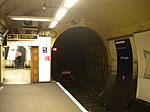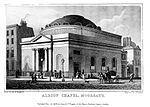Statue of John Keats, Moorgate
2024 in London2024 sculpturesBuildings and structures in the City of LondonOutdoor sculptures in LondonSculpture stubs ... and 2 more
Statues of men in LondonStatues of writers

A statue of the English Romantic poet John Keats is located in Moorfields, Moorgate in the City of London. It was sculpted by Martin Jennings and depicts a larger than life-size copy of a life mask of Keats taken aged 21. Keats was the son of an ostler at the nearby inn, The Swan and Hoop. It was unveiled by Michael Mainelli, the Lord Mayor of London, on 31 October 2024, the 229th anniversary of Keats' birth. The circular base of slate around the plinth is inscribed with a quote from the fifth stanza of Keats' 1819 Ode on Indolence: It was funded by Alderman Bob Hall who had previously funded the John Donne Memorial near St Paul's Cathedral.
Excerpt from the Wikipedia article Statue of John Keats, Moorgate (License: CC BY-SA 3.0, Authors, Images).Statue of John Keats, Moorgate
Barbican Highwalks, City of London
Geographical coordinates (GPS) Address Nearby Places Show on map
Geographical coordinates (GPS)
| Latitude | Longitude |
|---|---|
| N 51.517694 ° | E -0.089197 ° |
Address
Moor House
Barbican Highwalks
EC2Y 9AA City of London
England, United Kingdom
Open on Google Maps









